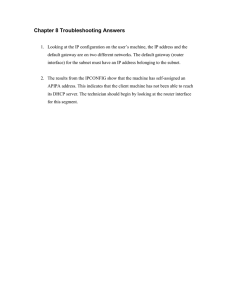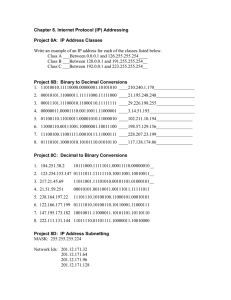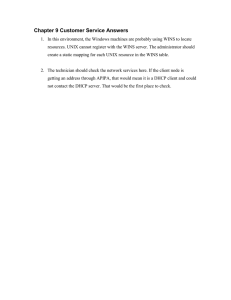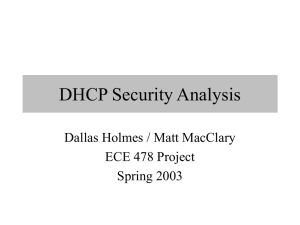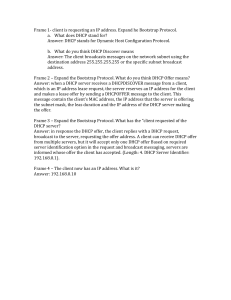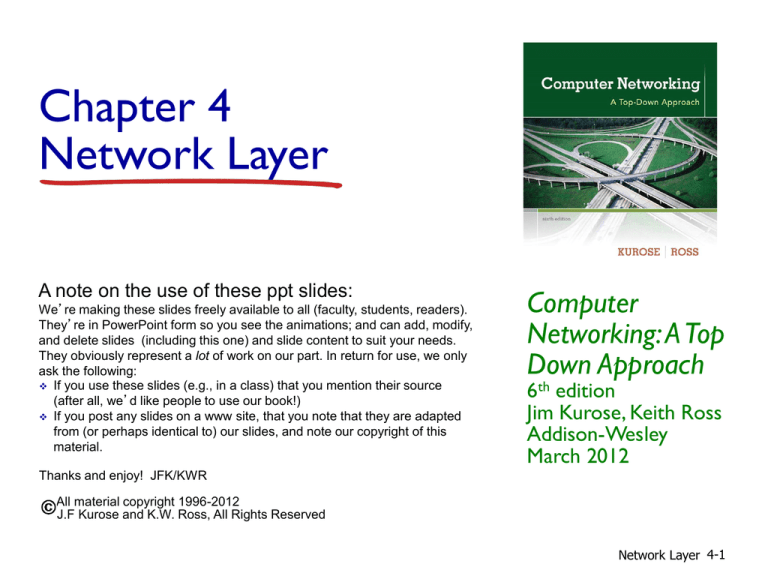
Chapter 4
Network Layer
A note on the use of these ppt slides:
We’re making these slides freely available to all (faculty, students, readers).
They’re in PowerPoint form so you see the animations; and can add, modify,
and delete slides (including this one) and slide content to suit your needs.
They obviously represent a lot of work on our part. In return for use, we only
ask the following:
If you use these slides (e.g., in a class) that you mention their source
(after all, we’d like people to use our book!)
If you post any slides on a www site, that you note that they are adapted
from (or perhaps identical to) our slides, and note our copyright of this
material.
Computer
Networking: A Top
Down Approach
6th edition
Jim Kurose, Keith Ross
Addison-Wesley
March 2012
Thanks and enjoy! JFK/KWR
All material copyright 1996-2012
J.F Kurose and K.W. Ross, All Rights Reserved
Network Layer 4-1
Chapter 4: outline
4.1 introduction
4.2 virtual circuit and
datagram networks
4.3 what’s inside a router
4.4 IP: Internet Protocol
datagram format
IPv4 addressing
ICMP
IPv6
4.5 routing algorithms
link state
distance vector
hierarchical routing
4.6 routing in the Internet
RIP
OSPF
BGP
4.7 broadcast and multicast
routing
Network Layer 4-2
Network layer
transport segment from
sending to receiving host
on sending side
encapsulates segments
into datagrams
on receiving side, delivers
segments to transport
layer
network layer protocols
in every host, router
router examines header
fields in all IP datagrams
passing through it
application
transport
network
data link
physical
network
data link
physical
network
data link
physical
network
data link
physical
network
data link
physical
network
data link
physical
network
data link
physical
network
data link
physical
network
data link
physical
network
data link
physical
network
data link
physical
network
data link
physical
application
transport
network
data link
physical
Network Layer 4-3
Two key network-layer functions
forwarding: move packets
from router’s input to
appropriate router
output
routing: determine route
taken by packets from
source to dest.
routing algorithms
analogy:
routing: process of
planning trip from source
to dest
forwarding: process of
getting through single
interchange
Network Layer 4-4
Interplay between routing and forwarding
routing algorithm
routing algorithm determines
end-end-path through network
local forwarding table
header value output link
forwarding table determines
local forwarding at this router
0100
0101
0111
1001
3
2
2
1
value in arriving
packet’s header
0111
1
3 2
Network Layer 4-5
Chapter 4: outline
4.1 introduction
4.2 virtual circuit and
datagram networks
4.3 what’s inside a router
4.4 IP: Internet Protocol
datagram format
IPv4 addressing
ICMP
IPv6
4.5 routing algorithms
link state
distance vector
hierarchical routing
4.6 routing in the Internet
RIP
OSPF
BGP
4.7 broadcast and multicast
routing
Network Layer 4-6
IP addressing: introduction
223.1.1.1
IP address: 32-bit
identifier for host, router
interface
223.1.1.2
interface: connection
between host/router and
physical link
223.1.2.1
223.1.1.4
223.1.3.27
223.1.1.3
223.1.2.2
routers typically have
multiple interfaces
host typically has one
active interface (e.g., wired
Ethernet, wireless 802.11)
one IP address associated
with each interface
223.1.2.9
223.1.3.1
223.1.3.2
223.1.1.1 = 11011111 00000001 00000001 00000001
223
1
1
1
Network Layer 4-7
IP addressing: introduction
Q: how are interfaces
actually connected?
A: we’ll learn about that
in chapter 5, 6.
223.1.1.1
223.1.2.1
223.1.1.2
223.1.1.4
223.1.1.3
223.1.2.9
223.1.3.27
223.1.2.2
A: wired Ethernet interfaces
connected by Ethernet switches
223.1.3.1
For now: don’t need to worry
about how one interface is
connected to another (with no
intervening router)
223.1.3.2
A: wireless WiFi interfaces
connected by WiFi base station
Network Layer 4-8
Subnets
IP
address:
subnet part - high order
bits
host part - low order
bits
what
’s a subnet ?
device interfaces with
same subnet part of IP
address
can physically reach
each other without
intervening router
223.1.1.1
223.1.1.2
223.1.1.4
223.1.2.1
223.1.2.9
223.1.2.2
223.1.1.3
223.1.3.27
subnet
223.1.3.1
223.1.3.2
network consisting of 3 subnets
Network Layer 4-9
Subnets
223.1.1.0/24
223.1.2.0/24
recipe
to determine the
subnets, detach each
interface from its host
or router, creating
islands of isolated
networks
each isolated network
is called a subnet
223.1.1.1
223.1.1.2
223.1.1.4
223.1.2.1
223.1.2.9
223.1.2.2
223.1.1.3
223.1.3.27
subnet
223.1.3.1
223.1.3.2
223.1.3.0/24
subnet mask: /24
Network Layer 4-10
Subnets
223.1.1.2
how many?
223.1.1.1
223.1.1.4
223.1.1.3
223.1.9.2
223.1.7.0
223.1.9.1
223.1.7.1
223.1.8.1
223.1.8.0
223.1.2.6
223.1.2.1
223.1.3.27
223.1.2.2
223.1.3.1
223.1.3.2
Network Layer 4-11
IP addressing: CIDR
CIDR: Classless InterDomain Routing
subnet portion of address of arbitrary length
address format: a.b.c.d/x, where x is # bits in
subnet portion of address
subnet
part
host
part
11001000 00010111 00010000 00000000
200.23.16.0/23
Network Layer 4-12
IP addresses: how to get one?
Q: how does network get subnet part of IP addr?
A: gets allocated portion of its provider ISP’s address
space
ISP's block
11001000 00010111 00010000 00000000
200.23.16.0/20
Organization 0
Organization 1
Organization 2
...
11001000 00010111 00010000 00000000
11001000 00010111 00010010 00000000
11001000 00010111 00010100 00000000
…..
….
200.23.16.0/23
200.23.18.0/23
200.23.20.0/23
….
Organization 7
11001000 00010111 00011110 00000000
200.23.30.0/23
Network Layer 4-13
Hierarchical addressing: route aggregation
hierarchical addressing allows efficient advertisement of routing
information:
Organization 0
200.23.16.0/23
Organization 1
200.23.18.0/23
Organization 2
200.23.20.0/23
Organization 7
.
.
.
.
.
.
Fly-By-Night-ISP
“Send me anything
with addresses
beginning
200.23.16.0/20”
Internet
200.23.30.0/23
ISPs-R-Us
“Send me anything
with addresses
beginning
199.31.0.0/16”
Network Layer 4-14
Hierarchical addressing: more specific routes
ISPs-R-Us has a more specific route to Organization 1
Organization 0
200.23.16.0/23
Organization 2
200.23.20.0/23
Organization 7
.
.
.
.
.
.
Fly-By-Night-ISP
“Send me anything
with addresses
beginning
200.23.16.0/20”
Internet
200.23.30.0/23
ISPs-R-Us
Organization 1
200.23.18.0/23
“Send me anything
with addresses
beginning 199.31.0.0/16
or 200.23.18.0/23”
Network Layer 4-15
IP addressing: how to get a block?
Q: how does an ISP get block of addresses?
A: ICANN: Internet Corporation for Assigned
Names and Numbers http://www.icann.org/
allocates addresses
manages DNS
assigns domain names, resolves disputes
Network Layer 4-16
IP addresses: how to get one?
Q: How does a host get IP address?
hard-coded by system admin in a file
Windows: control-panel->network->configuration>tcp/ip->properties
UNIX: /etc/rc.config
DHCP: Dynamic Host Configuration Protocol:
dynamically get address from as server
“plug-and-play”
Network Layer 4-17
DHCP: Dynamic Host Configuration Protocol
goal: allow host to dynamically obtain its IP address from network
server when it joins network
can renew its lease on address in use
allows reuse of addresses (only hold address while
connected/“on”)
support for mobile users who want to join network (more
shortly)
DHCP overview:
host broadcasts “DHCP discover” msg [optional]
DHCP server responds with “DHCP offer” msg [optional]
host requests IP address: “DHCP request” msg
DHCP server sends address: “DHCP ack” msg
Network Layer 4-18
DHCP client-server scenario
DHCP
server
223.1.1.0/24
223.1.2.1
223.1.1.1
223.1.1.2
223.1.1.4
223.1.1.3
223.1.2.9
223.1.3.27
223.1.2.2
arriving DHCP
client needs
address in this
network
223.1.2.0/24
223.1.3.2
223.1.3.1
223.1.3.0/24
Network Layer 4-19
DHCP client-server scenario
DHCP server: 223.1.2.5
DHCP discover
src : 0.0.0.0, 68
dest.: 255.255.255.255,67
yiaddr: 0.0.0.0
transaction ID: 654
arriving
client
DHCP offer
src: 223.1.2.5, 67
dest: 255.255.255.255, 68
yiaddrr: 223.1.2.4
transaction ID: 654
lifetime: 3600 secs
DHCP request
src: 0.0.0.0, 68
dest:: 255.255.255.255, 67
yiaddrr: 223.1.2.4
transaction ID: 655
lifetime: 3600 secs
DHCP ACK
src: 223.1.2.5, 67
dest: 255.255.255.255, 68
yiaddrr: 223.1.2.4
transaction ID: 655
lifetime: 3600 secs
Network Layer 4-20
DHCP: more than IP addresses
DHCP returns:
IP address
address of first-hop router for client
name and IP address of DNS sever
network mask (indicating network versus host portion
of address)
Network Layer 4-21
DHCP: example
DHCP
UDP
IP
Eth
Phy
DHCP
DHCP
DHCP
DHCP
DHCP
DHCP
DHCP
DHCP
DHCP
DHCP
UDP
IP
Eth
Phy
168.1.1.1
router with DHCP
server built into
router
connecting laptop needs
its IP address, addr of
first-hop router, addr of
DNS server: use DHCP
DHCP request encapsulated
in UDP, encapsulated in IP,
encapsulated in 802.3
Ethernet
Ethernet frame broadcast
(dest: FFFFFFFFFFFF) on LAN,
received at router running
DHCP server
Ethernet demuxed to IP
demuxed, UDP demuxed to
DHCP
Network Layer 4-22
DHCP: example
DHCP
UDP
IP
Eth
Phy
DHCP
DHCP
DHCP
DHCP
DHCP
DHCP
DHCP
DHCP
DHCP
DHCP
UDP
IP
Eth
Phy
router with DHCP
server built into
router
DCP server formulates
DHCP ACK containing
client’s IP address, IP
address of first-hop
router for client, name &
IP address of DNS server
encapsulation of DHCP
server, frame forwarded
to client, demuxing up to
DHCP at client
client now knows its IP
address, name and IP
address of DSN server, IP
address of its first-hop
router
Network Layer 4-23
DHCP: Wireshark
output (home LAN)
Message type: Boot Request (1)
Hardware type: Ethernet
Hardware address length: 6
Hops: 0
Transaction ID: 0x6b3a11b7
Seconds elapsed: 0
Bootp flags: 0x0000 (Unicast)
Client IP address: 0.0.0.0 (0.0.0.0)
Your (client) IP address: 0.0.0.0 (0.0.0.0)
Next server IP address: 0.0.0.0 (0.0.0.0)
Relay agent IP address: 0.0.0.0 (0.0.0.0)
Client MAC address: Wistron_23:68:8a (00:16:d3:23:68:8a)
Server host name not given
Boot file name not given
Magic cookie: (OK)
Option: (t=53,l=1) DHCP Message Type = DHCP Request
Option: (61) Client identifier
Length: 7; Value: 010016D323688A;
Hardware type: Ethernet
Client MAC address: Wistron_23:68:8a (00:16:d3:23:68:8a)
Option: (t=50,l=4) Requested IP Address = 192.168.1.101
Option: (t=12,l=5) Host Name = "nomad"
Option: (55) Parameter Request List
Length: 11; Value: 010F03062C2E2F1F21F92B
1 = Subnet Mask; 15 = Domain Name
3 = Router; 6 = Domain Name Server
44 = NetBIOS over TCP/IP Name Server
……
request
Message type: Boot Reply (2)
Hardware type: Ethernet
Hardware address length: 6
Hops: 0
Transaction ID: 0x6b3a11b7
Seconds elapsed: 0
Bootp flags: 0x0000 (Unicast)
Client IP address: 192.168.1.101 (192.168.1.101)
Your (client) IP address: 0.0.0.0 (0.0.0.0)
Next server IP address: 192.168.1.1 (192.168.1.1)
Relay agent IP address: 0.0.0.0 (0.0.0.0)
Client MAC address: Wistron_23:68:8a (00:16:d3:23:68:8a)
Server host name not given
Boot file name not given
Magic cookie: (OK)
Option: (t=53,l=1) DHCP Message Type = DHCP ACK
Option: (t=54,l=4) Server Identifier = 192.168.1.1
Option: (t=1,l=4) Subnet Mask = 255.255.255.0
Option: (t=3,l=4) Router = 192.168.1.1
Option: (6) Domain Name Server
Length: 12; Value: 445747E2445749F244574092;
IP Address: 68.87.71.226;
IP Address: 68.87.73.242;
IP Address: 68.87.64.146
Option: (t=15,l=20) Domain Name = "hsd1.ma.comcast.net."
reply
Network Layer 4-24
NAT: network address translation
rest of
Internet
local network
(e.g., home network)
10.0.0/24
10.0.0.1
10.0.0.4
10.0.0.2
138.76.29.7
10.0.0.3
all datagrams leaving local
network have same single
source NAT IP address:
138.76.29.7,different source
port numbers
datagrams with source or
destination in this network
have 10.0.0/24 address for
source, destination (as usual)
Network Layer 4-25
NAT: network address translation
motivation: local network uses just one IP address as far
as outside world is concerned:
range of addresses not needed from ISP: just one
IP address for all devices
can change addresses of devices in local network
without notifying outside world
can change ISP without changing addresses of
devices in local network
devices inside local net not explicitly addressable,
visible by outside world (a security plus)
Network Layer 4-26
NAT: network address translation
implementation: NAT router must:
outgoing datagrams: replace (source IP address, port #) of
every outgoing datagram to (NAT IP address, new port #)
. . . remote clients/servers will respond using (NAT IP
address, new port #) as destination addr
remember (in NAT translation table) every (source IP address,
port #) to (NAT IP address, new port #) translation pair
incoming datagrams: replace (NAT IP address, new port #) in
dest fields of every incoming datagram with corresponding
(source IP address, port #) stored in NAT table
Network Layer 4-27
NAT: network address translation
2: NAT router
changes datagram
source addr from
10.0.0.1, 3345 to
138.76.29.7, 5001,
updates table
NAT translation table
WAN side addr
LAN side addr
1: host 10.0.0.1
sends datagram to
128.119.40.186, 80
138.76.29.7, 5001 10.0.0.1, 3345
……
……
S: 10.0.0.1, 3345
D: 128.119.40.186, 80
10.0.0.1
1
2
S: 138.76.29.7, 5001
D: 128.119.40.186, 80
138.76.29.7
S: 128.119.40.186, 80
D: 138.76.29.7, 5001
3: reply arrives
dest. address:
138.76.29.7, 5001
3
10.0.0.4
S: 128.119.40.186, 80
D: 10.0.0.1, 3345
10.0.0.2
4
10.0.0.3
4: NAT router
changes datagram
dest addr from
138.76.29.7, 5001 to 10.0.0.1, 3345
Network Layer 4-28
NAT: network address translation
16-bit port-number field:
60,000 simultaneous connections with a single
LAN-side address!
NAT is controversial:
routers should only process up to layer 3
violates end-to-end argument
• NAT possibility must be taken into account by app
designers, e.g., P2P applications
address shortage should instead be solved by
IPv6
Network Layer 4-29
NAT traversal problem
client wants to connect to
server with address 10.0.0.1
server address 10.0.0.1 local to
LAN (client can’t use it as
destination addr)
only one externally visible NATed
address: 138.76.29.7
solution1: statically configure
NAT to forward incoming
connection requests at given
port to server
10.0.0.1
client
?
10.0.0.4
138.76.29.7
NAT
router
e.g., (123.76.29.7, port 25000)
always forwarded to 10.0.0.1 port
25000
Network Layer 4-30
NAT traversal problem
solution 2: Universal Plug and Play
(UPnP) Internet Gateway Device
(IGD) Protocol. Allows NATed
host to:
learn public IP address
(138.76.29.7)
add/remove port mappings
(with lease times)
10.0.0.1
IGD
NAT
router
i.e., automate static NAT port
map configuration
Network Layer 4-31
NAT traversal problem
solution 3: relaying (used in Skype)
NATed client establishes connection to relay
external client connects to relay
relay bridges packets between to connections
2. connection to
relay initiated
by client
client
3. relaying
established
1. connection to
relay initiated
by NATed host
138.76.29.7
10.0.0.1
NAT
router
Network Layer 4-32

